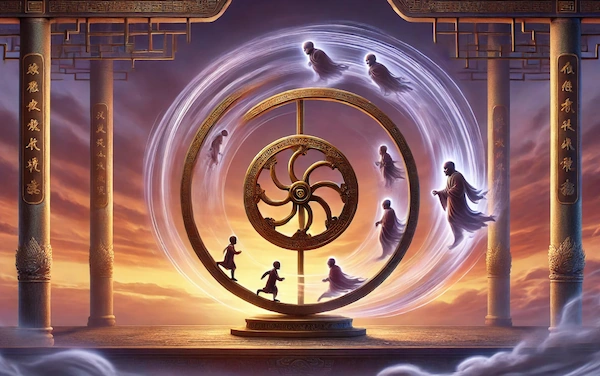
Introduction to the Apocryphon of John
The text known as the Apocryphon of John, or Secret Book of John, represents one of the most significant Gnostic writings discovered in the Nag Hammadi library in Egypt in 1945. This profound work offers a radical alternative to orthodox Christian theological frameworks, challenging conventional understandings of divinity, creation, and human spiritual potential. The Apocryphon provides a comprehensive cosmological system that illuminates the core tenets of Gnostic philosophy: the nature of the divine, the origins of creation, and humanity’s spiritual predicament and potential for transcendence.
As a foundational Gnostic text, the Apocryphon of John emerges from a diverse religious landscape in the early centuries CE, when competing interpretations of spiritual reality flourished alongside nascent orthodox Christianity. Its significance extends beyond historical interest, offering contemporary readers insights into perennial philosophical questions about consciousness, divine nature, and the human experience of suffering and enlightenment.
Philosophical and Spiritual Aspects
The Apocryphon of John presents an intricate cosmological framework that establishes a profound distinction between the spiritual and material realms. The text unfolds as a post-resurrection dialogue between Jesus and John the Apostle, wherein Jesus imparts esoteric truths about the fundamental nature of existence. Central to this revelation is the concept of the Pleroma—the realm of divine fullness and perfect spiritual harmony inhabited by emanations of divinity called aeons. These aeons proceed from an ultimate transcendent source identified as the Monad or the One—an ineffable, inconceivable principle beyond all attributes and categories.
The Monad in the Apocryphon represents absolute transcendence, described in apophatic terms (what it is not) rather than cataphatic terms (what it is). This Supreme Being exists beyond comprehension, beyond gender, beyond form, beyond even existence itself—a perfect unity that transcends all duality. From this ineffable source emanate the aeons, who collectively constitute the Pleroma, representing diverse aspects of divine consciousness in harmonious relationship.
One of the most profound philosophical contributions of this text is its conception of gnosis. Unlike conventional religious knowledge based on dogma or received tradition, gnosis represents direct, experiential understanding of divine reality that transforms the knower. The Apocryphon clearly articulates this soteriological principle when it states: “For it is not through faith alone that one will be saved but through knowledge.” This assertion directly challenges orthodox Christianity’s emphasis on salvation through faith in Christ’s sacrificial atonement, suggesting instead that true liberation comes through inner awakening to one’s divine nature.
The narrative introduces Sophia, a feminine aeon embodying divine wisdom, whose role proves pivotal in the cosmic drama. Driven by desire to comprehend the incomprehensible source—the Monad—Sophia acts independently, without her consort’s participation. This unbalanced action generates a crisis in the divine order, resulting in the creation of Yaldabaoth, a flawed demiurge possessing Sophia’s power but lacking her wisdom. Believing himself to be the supreme deity, Yaldabaoth proclaims: “I am God and there is no other God beside me“—a declaration revealing profound ignorance of the transcendent reality above him.
This cosmogonic myth fundamentally reframes the creation narrative found in Genesis. Rather than depicting creation as the intentional act of a benevolent deity, the Apocryphon presents the material cosmos as the product of error, ignorance, and spiritual deficiency. Yaldabaoth, assisted by archons (ruling powers), fashions the physical world as a prison of matter, designed to entrap divine sparks of consciousness.
The Apocryphon’s anthropology—its understanding of human nature—proves equally revolutionary. Humans are portrayed as composite beings with physical bodies created by the demiurge but containing a divine spark or pneuma originating from the Pleroma. This divine element remains trapped in materiality, forgotten and dormant until awakened through gnosis. The text powerfully conveys this hidden truth about human identity when it states: “You are not what you think you are; you are not what you see.” This declaration invites profound contemplation on the illusory nature of conventional identity and the transcendent potential within each person.
The salvific path outlined in the Apocryphon centers on recognition—anamnesis or “unforgetting”—wherein the soul remembers its divine origins. This recollection liberates consciousness from identification with the material body and the false self constructed by the demiurge’s archons. Unlike orthodox religious frameworks that emphasize correct belief or ritual observance, the Gnostic path focuses on inner transformation through direct experiential knowledge of ultimate reality.
Influence on Gnostic Tradition
The Apocryphon of John has exerted profound influence on Gnostic thought, establishing paradigmatic patterns for understanding cosmology, anthropology, and soteriology that permeate various Gnostic systems. Its comprehensive framework provided coherence to diverse Gnostic communities, offering a systematic explanation for human suffering and alienation while simultaneously providing a path toward spiritual liberation.
The text’s emphasis on gnosis as the essential component of salvation resonates throughout numerous Gnostic traditions, from Valentinian to Sethian systems. By privileging direct spiritual knowledge over institutionalized religious authority, the Apocryphon establishes a radically individualistic spiritual epistemology that continues to influence esoteric traditions down to the present day. This approach fundamentally challenges hierarchical religious structures by suggesting that authentic spiritual understanding emerges from within rather than from external authority.
Moreover, the Apocryphon functions as a sophisticated counter-narrative to orthodox Christianity by reinterpreting biblical figures and events through a radically different metaphysical lens. Where canonical texts present the creator God as wholly benevolent and omnipotent, the Apocryphon identifies this deity as Yaldabaoth—an imperfect, ignorant demiurge mistakenly believing himself supreme. This inversion transforms the entire moral framework of creation, positioning the serpent in Eden not as a tempter but as an emissary of divine wisdom offering liberating knowledge to humanity.
The text also reconfigures the role of Jesus, depicting him not primarily as a sacrificial redeemer but as a revealer of salvific knowledge—a divine messenger awakening humanity to its true nature and origin. This interpretation reframes Jesus’s significance within a philosophical framework centered on consciousness rather than sin and atonement.
Unique Features Compared to Other Gnostic Texts
The Apocryphon of John distinguishes itself within the corpus of Gnostic literature through several remarkable characteristics. First, its exceptional cosmological sophistication provides a comprehensive explanation of divine reality, cosmic origins, and human existence. Unlike other significant Gnostic texts that offer fragmentary glimpses of metaphysical principles, the Apocryphon presents a complete systematic framework interconnecting ontology, cosmogony, and anthropology into a coherent whole.
Where the Gospel of Thomas primarily collects sayings attributed to Jesus without developing extensive mythological narratives, and the Gospel of Mary focuses on Mary Magdalene’s spiritual insights without elaborate cosmological speculation, the Apocryphon of John integrates detailed mythological exposition with practical soteriological guidance. This integration creates a text of unusual philosophical and theological depth, addressing both abstract metaphysical questions and immediate existential concerns.
The text’s dialogical structure between Jesus and John creates an intimate pedagogical framework that emphasizes the transmission of esoteric knowledge from master to disciple. This narrative device establishes a model for personal revelation that contrasts sharply with communal or ecclesiastical modes of religious instruction found in canonical texts. While gospels like Matthew or Luke present Jesus teaching through parables intended for general audiences, the Apocryphon portrays Jesus imparting secret wisdom to a single receptive disciple—suggesting that the highest truths are accessible only to prepared individuals rather than to undifferentiated masses.
Additionally, the Apocryphon’s detailed treatment of feminine divine principles through figures like Barbelo (the first emanation from the Monad) and Sophia represents a significant contribution to religious thought. These feminine hypostases play crucial roles in both creation and salvation, offering a theological perspective that transcends conventional gender categories found in mainstream religious traditions. This emphasis on divine feminine principles provides balance to the predominantly masculine imagery typically used to represent divinity in Abrahamic religions.
Comparisons with Canonical Texts
A comparative analysis of the Apocryphon of John with canonical texts from Christianity, Judaism, and Islam reveals profound philosophical and theological divergences regarding fundamental questions of divine nature, creation, salvation, and human potential.
Nature of God
The orthodox Christian conception of God, particularly as articulated in Genesis and developed through patristic theology, presents a unified divine being characterized by omniscience, omnipotence, and perfect goodness. Genesis 1:31 affirms that “God saw everything that he had made was very good,” establishing a worldview in which creator and creation exist in harmonious relationship. This perspective develops further in Trinitarian theology, which maintains divine unity while acknowledging relational complexity within the Godhead.
By contrast, the Apocryphon introduces a radical distinction between the true transcendent deity (the ineffable Monad) and the creator of the material world (Yaldabaoth). This bifurcation resolves the philosophical problem of evil by attributing material existence—with its suffering and imperfection—to a secondary deity rather than to the ultimate divine principle. Yaldabaoth represents ignorance personified, a spiritual being who falsely proclaims: “I am God and there is no other God beside me.” This misapprehension demonstrates the fundamental Gnostic principle that ignorance, rather than moral transgression, constitutes the primary spiritual problem.
This dualistic conception stands in marked contrast to the monotheistic traditions of Judaism and Islam, where YHWH and Allah respectively represent singular divine realities responsible for both creation and redemption. The Jewish Shema declares: “Hear, O Israel: The Lord our God, the Lord is one” (Deuteronomy 6:4), while the Islamic doctrine of Tawhid similarly emphasizes divine unity and singularity. The Apocryphon challenges these monotheistic frameworks by separating creative function from ultimate divine reality, thus addressing the philosophical problem of how perfect divinity could create an imperfect world.
Creation
The Genesis account depicts creation as an intentional, sequential process whereby God brings order from chaos through divine speech: “And God said, Let there be light: and there was light” (Genesis 1:3). Each creative act is pronounced “good,” culminating in humanity’s creation as bearers of the divine image. This narrative establishes a fundamentally positive view of material existence as the product of divine wisdom and benevolence.
The Apocryphon presents a dramatically different cosmogony wherein material creation results from cosmic error rather than divine intention. According to this account, when Sophia acts without her consort’s participation (violating Pleroma’s principle of complementary partnership), her unbalanced action generates Yaldabaoth, who subsequently creates the material cosmos in ignorance of higher realities. This creation myth transforms the material world from divine gift to cosmic prison—a realm designed to entrap divine consciousness in matter.
The text elaborates that Yaldabaoth and his archons fashion the human body as a lure to capture the divine light glimpsed from the higher realm. This inverts the traditional understanding of the human body as “very good” (Genesis 1:31), recasting physical existence as a restricting mechanism limiting spiritual consciousness. This perspective aligns with broader Gnostic convictions about the illusory or corrupt nature of materiality compared to authentic spiritual reality.
Salvation
Orthodox Christianity centers its soteriology on faith in Christ’s redemptive sacrifice, as expressed in passages like John 3:16: “For God so loved the world, that he gave his only begotten Son, that whosoever believeth in him should not perish, but have everlasting life.” This framework emphasizes divine initiative in salvation, the historical reality of Christ’s incarnation and resurrection, and the communal nature of faith within ecclesiastical structures.
The Apocryphon articulates a radically different understanding of salvation through its emphasis on gnosis—direct experiential knowledge of divine reality. This knowledge does not primarily concern historical events or theological propositions but involves recognition of one’s true nature and origin. The text explicitly states that salvation comes “not through faith alone… but through knowledge“—knowledge that awakens the divine spark within from its slumber in materiality.
This soteriological paradigm shifts emphasis from external savior to internal awakening, from historical event to timeless self-recognition, and from communal confession to individual illumination. Where orthodox Christianity emphasizes Christ’s uniqueness as the sole mediator between humanity and God, the Apocryphon suggests that Christ functions as an exemplar and revealer of potential gnosis available to all who possess the divine spark.
Human Nature
The Jewish understanding of human nature, particularly as expressed in wisdom literature like Ecclesiastes, emphasizes humanity’s place within a covenantal relationship with God. This relationship entails moral responsibility and divine judgment, with human fulfillment arising from righteous living within community. Genesis 1:27 establishes human dignity through the concept of divine image: “So God created mankind in his own image, in the image of God he created them; male and female he created them.” This dignity carries with it ethical obligations within the created order.
The Apocryphon presents a dramatically different anthropology wherein human beings consist of multiple elements from different cosmic sources: a physical body created by the demiurge, a soul or psychic component provided by the archons, and a pneumatic element—a divine spark originating from the Pleroma. This compound nature creates an existential crisis wherein most humans remain unaware of their true spiritual identity, identifying instead with the physical and psychic aspects of their being.
According to this Gnostic perspective, authentic human identity lies not in ethical behavior within community but in conscious reconnection with one’s divine origin. The text suggests that humanity is fundamentally trapped within a flawed material creation, with liberation possible only through recognition of one’s transcendent nature. This anthropology divides humanity into categories based on their dominant element and receptivity to gnosis: the hylic (materially-oriented), psychic (soul-oriented), and pneumatic (spirit-oriented).
Prophetic Revelation
Islamic tradition emphasizes the centrality of prophetic revelation as the primary channel of divine communication. The Quran affirms: “We believe in Allah and that which has been revealed to us and that which was revealed to Abraham and Ishmael and Isaac and Jacob and the tribes, and that which was given to Moses and Jesus, and that which was given to the prophets from their Lord” (Quran 2:285). This establishes a model wherein chosen individuals receive and transmit divine messages that guide the community of believers in faith and practice.
The Apocryphon fundamentally reorients this understanding by privileging direct personal revelation over externally mediated prophetic authority. While the text presents itself as Jesus’s revelation to John, this revelation primarily serves to awaken the recipient’s own innate capacity for direct divine knowledge. The emphasis falls not on obedience to externally revealed law but on internal awakening to transcendent truth.
This approach radically democratizes spiritual authority by suggesting that each individual possessing the divine spark can access divine wisdom directly, without necessary mediation through institutional structures or scriptural traditions. This internalized form of revelation stands in tension with traditional religious frameworks that emphasize community cohesion through shared adherence to externally revealed teachings.
Conclusion
The Apocryphon of John represents one of the most philosophically sophisticated expressions of Gnostic thought, offering a comprehensive alternative to orthodox religious frameworks through its intricate cosmology, radical theology, and transformative soteriology. Its enduring significance lies in its bold reimagining of fundamental metaphysical questions: the nature of ultimate reality, the origins of creation, the human condition, and the path to spiritual liberation.
By positing a distinction between the transcendent divine and the creator of the material world, the text addresses the perennial philosophical problem of reconciling divine perfection with worldly suffering. Its emphasis on gnosis as direct experiential knowledge challenges conventional religious epistemologies that privilege faith or tradition over personal insight. Meanwhile, its complex anthropology offers a nuanced understanding of human consciousness that resonates with contemporary psychological theories about the multilayered self.
The text’s radical reinterpretation of biblical narratives demonstrates the philosophical richness of early Christian discourse, reminding us that orthodoxy emerged through contested debates rather than monolithic consensus. By recovering these alternative voices, contemporary readers gain access to philosophical perspectives that challenge conventional assumptions about divinity, materiality, and human potential.
In an age characterized by tremendous amount of confusion regarding what is material and what is instead spiritual, the Apocryphon’s emphasis on direct personal experience of transcendent reality continues to resonate. Its invitation to look beyond surface appearances to discover deeper truth—expressed in the profound statement “You are not what you think you are; you are not what you see“—offers a timeless philosophical challenge to conventional understandings of identity and reality.
The Apocryphon of John thus stands as both historical artifact and living wisdom, offering contemporary seekers a sophisticated philosophical framework for contemplating perennial questions about consciousness, suffering, and transcendence beyond the constraints of orthodox religious doctrine.
Some Eloquent Quotes From the Apocryphon of John
<<The One who is both invisible and visible, the one who is both unnameable and named…>>
This quote reflects the dual nature of the divine, emphasizing that God transcends human understanding and language. It suggests that while we can attempt to describe the divine, the true essence remains beyond our grasp.
<<From him came forth the only-begotten, who, being a powerful spirit, is the one who is the Bridge>>
Here, the text speaks of the relationship between the One and the only-begotten. The “Bridge” metaphor indicates a link between the divine and humanity, highlighting the significance of the only-begotten in facilitating understanding or access to the divine nature.
<<When the Father saw that the image of the Light was perfect, he rejoiced…>>
This passage addresses the idea of creation and divine joy. It implies that the act of creation is not just a mechanical process but involves a relational dynamic where the creator takes pleasure in the beauty and completeness of the creation.
<<You are the representation of the invisible spirit>>
This line speaks directly to the concept of humanity as a reflection of the divine. It suggests that within each person lies a part of this invisible spirit, urging readers to recognize their own divine potential and connection to the greater reality.
<<The knowledge of the ineffable is the beginning of the resurrection>>
This quote indicates that true understanding and spiritual knowledge lead to transformation and awakening, akin to a resurrection of the self. It emphasizes the importance of spiritual insight as a precursor to deeper experiences of life and existence.
The Gnostic Texts Series
1. The Gnostic Gospels: Why Are They Interesting From a Spiritual Perspective?
2. Cosmology and Spirituality in The Book of Enoch
3. Sophia of Jesus Christ: Feminine Divine Wisdom in Gnostic Thought
4. Pistis Sophia: Gnostic Insights into Knowledge and Spirituality
5. The Apocalypse of Peter: Gnostic Insights on Morality and Judgment
6. The Nature of God in the Apocryphon of John: A Gnostic Interpretation
7. Spiritual Dualism in the Second Treatise of the Great Seth
8. Materiality and Spirituality in the Hypostasis of the Archons
9. The Tripartite Tractate: Bridging Gnosticism and Hellenistic Thought
10. Contrasting Beliefs: The Gospel of Thomas vs. Canonical Texts
11. The Gospel of Mary: Feminine Authority in Gnostic Spirituality
12. The Gospel of Truth: The Conception of Christianity According to Valentinus
13. The Gospel of Philip: Mary Magdalene’s Role and the Meaning of Sacraments
14. The Exegesis on the Soul: A Subversive Journey of Spiritual Restoration
15. The Thunder, Perfect Mind: Paradox and Divine Femininity in Gnostic Wisdom
16. Sethian Texts and the Alchemical Transformation of Consciousness
IS THIS YOUR FIRST INCARNATION ON EARTH?
Read the following sentences and choose the ones that best describe what you think.
Count the total number of selected boxes and check the related profile.
0-1: You belong to this world and will come back again
2-3: You have been here before but have visited other worlds as well
4-5: You may have been here before, but you will soon leave
6: You are here for the first and last time
Further details on incarnating





